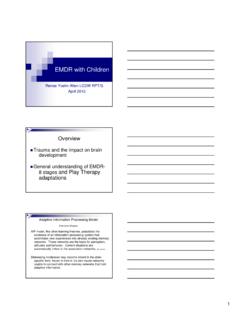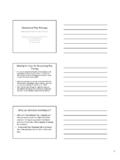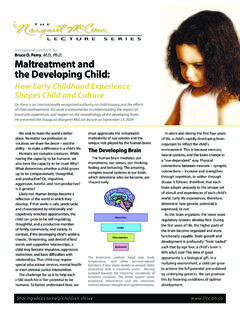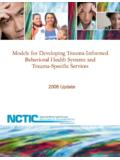Transcription of Resource-Focused EMDR: Integration of Ego State …
1 Reprint from the March 1999 EMDRIA NewsletterResource-Focused EMDR: Integration of Ego State therapy , alternating bilateral stimulation , and Art TherapyBy Shirley Jean Schmidt, MA, LPCEMDRIA-Approved ConsultantI conceptualize EMDR as the process of linking the trauma from one part of the brain to a solution inanother part of the brain, to reach an adaptive resolution. The standard EMDR protocol proposesaccomplishing this by focusing heavily on the trauma. Most of my clients are adult survivors ofchildhood trauma and their tolerance of a trauma-focused protocol is often low. I wondered if thesame adaptive resolution could be accomplished by focusing primarily on the part of the brainholding the solution rather than the trauma.
2 I recently began developing a resource-focusedprotocol, which borrows from Sandra Paulsen s (1994, 1995, & 1996) suggestions for integratingEMDR with ego State therapy , and Andrew Leeds (1997) protocol for resource development andresource installation (RD/RI). This new protocol puts significant emphasis on developing andstrengthening the felt sense of well-being connected to resource ego states before EMDR processing,and maintenance of the sense of well-being during EMDR processing. It involves using the clients drawings of resource ego states and traumatized ego states (drawn with the dominant and non-dominant hand) as anchors for ego State processing, and as the focal points in eye movements (EMs).
3 In this protocol, traumatic material is elicited only when sufficient internal resources, represented bydrawings, are displayed in front of the client. The intention of this approach is to minimize risk ofaffect overwhelm and maximize the probability that the part of the brain holding the trauma will linkto the part of the brain holding the my experience the Resource-Focused protocol accomplishes everything the trauma-focusedprotocol does desensitization of traumatic material, decrease in believability of the negativecognition, increase in believability of the positive cognition, and clearing of disturbing bodysensations. Clients who have experienced both trauma-focused and Resource-Focused EMDR report asignificant preference for the Resource-Focused approach.
4 Likewise, feedback from other EMDR therapists who have tried this has been very positive. In this article I will first touch on thecomponent parts of this innovation, then briefly describe the four-step Component Parts:The key components of the innovation presented here are well known in the field of psychotherapy,including: ego State therapy , alternating bilateral stimulation , imaginal split-screen technique, arttherapy, and the significance of expression via the dominant and non-dominant State therapy : I am very grateful for Mark Lawrence s two-part article on EMDR as a SpecialForm of Ego State Psychotherapy, which provides detailed historical and theoretical information onego State therapy .
5 It is highly recommended for readers unfamiliar with ego State therapy . (Part Iappeared in the December 1998 issue, Part II appears in this issue.) In most basic terms, ego statesare specialized neural networks that hold specific packages of information related to behavior, affect,sensations, and knowledge of our life experiences (Braun, 1988). For example, an ego State (neuralnetwork) specialized for interacting with intimidating authority figures will contain very differentinformation than an ego State specialized for playing with small children. Ego State therapy involvestherapist-facilitated Integration of needy ego states with resource states and mediation of conflictsbetween ego states .
6 It promotes communication, cooperation, and mutual appreciation within thefamily of parts, increasing their ability to work as a democratic bilateral stimulation (ABS): EMDR therapists are no strangers to ABS. Whether by eyemovements (EMs), audio stimulation , or tactile stimulation , ABS appears to play a critical role in theefficacy of EMDR therapy . While it is still unclear how it facilitates changes in the brain, it doesResource-Focused EMDRSJ Schmidt2seem to accelerate the brain s information processing, and to help facilitate the neural networkconnections needed for psychological split-screen technique: As early as 1991 Ron Martinez described using this with EMDR.
7 Itinvolves having a client hold a mental image of an internal resource alongside a mental imagerepresenting the dysfunctional material, like two photos side by side. By adding EMs, he found thepositive image strengthened and the negative image became less relevant. This is a helpfultechnique but some clients have trouble holding the mental images. Expanding on this concept, Ibegan asking clients draw their images (ego states ), as a way to make the "split screen" processingmore visual and hopefully more therapy : Therapists have been using art for years to better understand their clients perspectivesand to promote healing (Oster & Gould, 1987). A picture can often convey a wealth of informationthat can not easily be obtained verbally.
8 In my experience, when clients face their drawings duringEMDR processing, they stay better connected to the associated feelings, and perhaps consequentlyreach an adaptive resolution faster. (Basic training in art therapy principles is recommended fortherapists planning to use this approach.)Significance of artistic expression via the dominant and non-dominant hand: According to Carlson(1992), the right hemisphere is important for the recognition and expression of emotion andspecializes in global thinking, whereas the left hemisphere of the brain is the language center andspecializes in linear thinking. Research by Drake (1984) suggests that the right hemisphere processesinformation regarding negative affect, whereas the left hemisphere processes positive (1988) explains that whether a person is right-handed or left-handed, the dominanthand always connects to the hemisphere with the language center.
9 She advocates writing anddrawing with the non-dominant hand to facilitate therapeutic connection to the right hemisphere andcreative expression of inner child ego states . She also encourages resolving of internal conflicts bygenerating dialogue between right and left brain by writing with alternating left and right hands. Allof this suggests that unresolved trauma is stored in the right hemisphere, connected to the non-dominant hand, and that resources are stored in the left hemisphere connected to the EMDR: The Four-Step MethodStep One: Ego strength assessment and enhancement:I ll ask a client to draw a picture that represents for them a positive aspect of self (a resource egostate).
10 For example, I might ask something like: "Draw a picture which represents the part of youthat knows you are a worthwhile person." or "Draw a picture which represents the part of you thatknows how to nurture." or "Draw a picture which represents the part of you that is confident." I callthis a resource picture/part, (RP) and I ask them to draw it with their dominant hand. I like to askthem how their body feels while they are drawing or looking at their picture. If they are connectingto a truly healthy resource ego State they will enjoy a felt sense of well being connected to thepicture. I will display the RP on a felt board directly in front of the client and discuss the ll ask about the meaning and the significance to better understand how this resource can be used tofacilitate growth.






